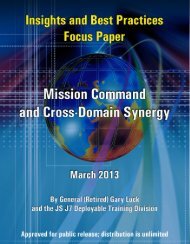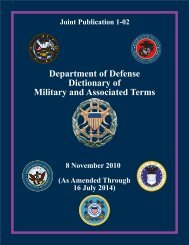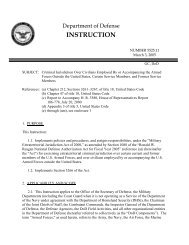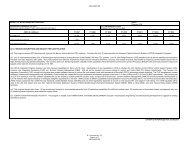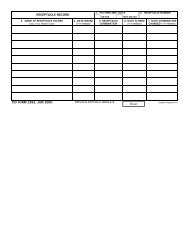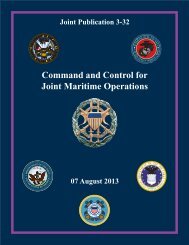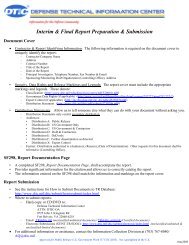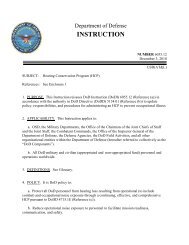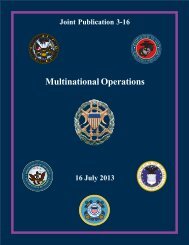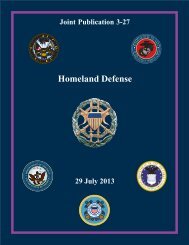JP 1, Doctrine for the Armed Forces of the United States - Defense ...
JP 1, Doctrine for the Armed Forces of the United States - Defense ...
JP 1, Doctrine for the Armed Forces of the United States - Defense ...
You also want an ePaper? Increase the reach of your titles
YUMPU automatically turns print PDFs into web optimized ePapers that Google loves.
Chapter IV<br />
subordinate JFC will accomplish Service ADCON. This relationship is appropriate when<br />
stability, continuity, economy, ease <strong>of</strong> long-range planning, and <strong>the</strong> scope <strong>of</strong> operations<br />
dictate organizational integrity <strong>of</strong> Service <strong>for</strong>ces <strong>for</strong> conducting operations.<br />
See Paragraph 8, “Service Component Commands,” <strong>for</strong> more in<strong>for</strong>mation on Service<br />
component commands.<br />
(3) The JFC can establish functional component commands to conduct operations.<br />
Functional component commands are appropriate when <strong>for</strong>ces from two or more Military<br />
Departments must operate within <strong>the</strong> same mission area or physical domain or <strong>the</strong>re is a need<br />
to accomplish a distinct aspect <strong>of</strong> <strong>the</strong> assigned mission. Joint <strong>for</strong>ce land, air, maritime, and<br />
SO component commanders are examples <strong>of</strong> functional components. (Note: Functional<br />
component commanders are component commanders <strong>of</strong> a joint <strong>for</strong>ce and do not constitute a<br />
“joint <strong>for</strong>ce command” with <strong>the</strong> authorities and responsibilities <strong>of</strong> a JFC, even when<br />
employing <strong>for</strong>ces from two or more Military Departments.) When a functional component<br />
command employs <strong>for</strong>ces from more than one Service, <strong>the</strong> functional component<br />
commander’s staff should include Service representatives from each <strong>of</strong> <strong>the</strong> employed Service<br />
<strong>for</strong>ces to aid in understanding those Service capabilities and maximizing <strong>the</strong> effective<br />
employment <strong>of</strong> Service <strong>for</strong>ces. Joint staff billets <strong>for</strong> needed expertise and individuals to fill<br />
those billets should be identified. Those individuals should be used when <strong>the</strong> functional<br />
component command is <strong>for</strong>med <strong>for</strong> exercises, contingency planning, or actual operations.<br />
See Paragraph 9, “Functional Component Commands,” <strong>for</strong> more in<strong>for</strong>mation on functional<br />
component commands.<br />
(4) Normally, joint <strong>for</strong>ces are organized with a combination <strong>of</strong> Service and<br />
functional component commands with operational responsibilities. Joint <strong>for</strong>ces organized<br />
with Army, Marine Corps, Navy, and Air Force components may have SOF (if assigned)<br />
organized as a functional component. The JFC defines <strong>the</strong> authority, command<br />
relationships, and responsibilities <strong>of</strong> <strong>the</strong> Service and functional component commanders;<br />
however, <strong>the</strong> Service responsibilities (i.e., administrative and logistics) <strong>of</strong> <strong>the</strong> components<br />
must be given due consideration by <strong>the</strong> JFC.<br />
(5) The JFC has full authority to assign missions, redirect ef<strong>for</strong>ts, and direct<br />
coordination among subordinate commanders. JFCs should allow Service tactical and<br />
operational assets and groupings to function generally as <strong>the</strong>y were designed and organized<br />
(e.g., carrier strike group; Marine air-ground task <strong>for</strong>ce [MAGTF]; US Air Force air and<br />
space expeditionary task <strong>for</strong>ces; US Army corps, divisions, brigade combat teams; and SO<br />
JTF). The intent is to meet <strong>the</strong> needs <strong>of</strong> <strong>the</strong> JFC while maintaining <strong>the</strong> tactical and<br />
operational integrity <strong>of</strong> <strong>the</strong> Service organizations. The following policy <strong>for</strong> C2 <strong>of</strong> <strong>United</strong><br />
<strong>States</strong> Marine Corps tactical air (TACAIR) recognizes this and deals with MAGTF aviation<br />
during sustained operations ashore.<br />
(a) The MAGTF commander will retain OPCON <strong>of</strong> organic air assets. The<br />
primary mission <strong>of</strong> <strong>the</strong> MAGTF aviation combat element is <strong>the</strong> support <strong>of</strong> <strong>the</strong> MAGTF<br />
ground combat element. During joint operations, <strong>the</strong> MAGTF air assets normally will be in<br />
support <strong>of</strong> <strong>the</strong> MAGTF mission. The MAGTF commander will make sorties available to <strong>the</strong><br />
IV-4 <strong>JP</strong> 1



